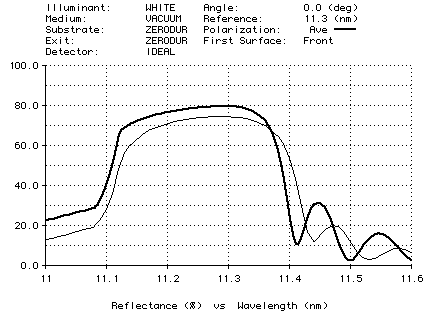Extreme Ultraviolet Mirrors
-
Mandeep Singh and Joseph J.M. Braat, "Design of multilayer extreme ultraviolet mirrors
for enhanced reflectivity", Appl. Opt., v. 39(13), 1 May 2000, pp. 2189-97,
the authors discuss the design of multilayer mirrors that reflect at 11.3 nm. A system of nine of such mirrors would be used to image the small features in future integrated circuits. Due to the large number of mirrors, even small increases in reflectivity can significantly improve the output of the system.
The following discussion is based on designs created after this paper was written. However, the results are very similar to those presented in the paper.
Materials in the EUV part of the spectrum have refractive indices close to 1. Hence, creating a mirror requires a large number of layers; each transition from a layer of one index to a layer of another index produces a small reflection. The authors start with a 80-period design consisting of alternating layers of beryllium (Be) and molybdenum (Mo) grown on Zerodur. There is also a thin layer of native oxide (BeO) on top of the outer-most layer. The formula for this coating is (AB)^80 C, where A=Mo, B=Be, and C=Be. The thickness of the layers are 2.3 nm for Mo, 3.4 nm for Be, and 2 nm for BeO. As shown in the plot below (as the light curve), the reflectance of this 161-layer coating at the 11.3 nm wavelength is 74.5%. Therefore, nine mirrors would reflect only 0.07% of the incident light.
The authors propose several methods of enhancing the reflectance. The most successful is to use a third material, rhodium (Rh), as the outer-most layer and alternating with Be and Mo. This design's formula is (DAB)^80 C, where C and D are Rh. Again, the thickness of C is 2 nm. The authors use TFCalc to optimize the thicknesses of the A, B, and D layers. They also removed all layers less than 0.6 nm thick, and reoptimized the design. The result is a 214-layer design having a reflectance of 80% at 11.3 nm. This result is shown as the heavy curve in the plot shown below. For nine mirrors, the output would be 0.13%, which is nearly a 100% better than the starting design.

n k
Be 1.0081 0.0010
BeO 0.9785 0.0102
Mo 0.9514 0.0046
Rh 0.9236 0.0089
Zerodur 0.9822 0.0146